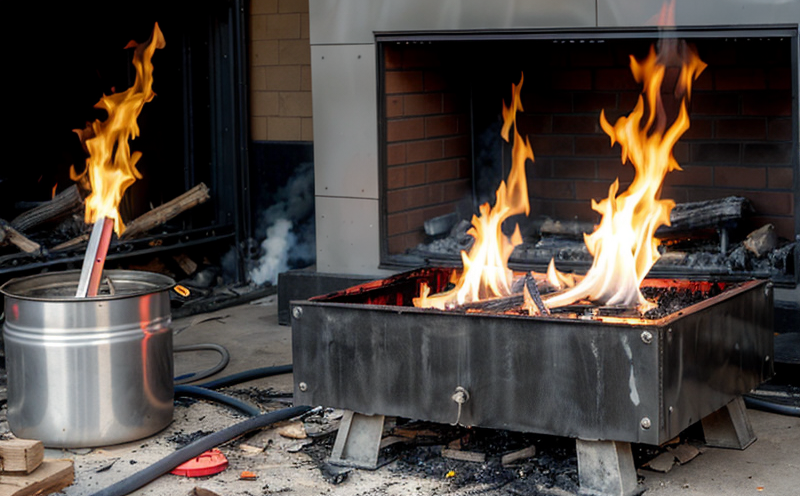IEC 60695 11 10 Horizontal and Vertical Flammability Testing
The IEC 60695-11-10 standard specifies the test methods for determining the horizontal and vertical flammability of materials used in electrical, electronic, and related products. This testing is crucial to ensure that components do not pose a fire hazard under specific environmental conditions.
The test involves placing a specimen on a specified surface (horizontal or vertical) and subjecting it to a flame source for a predefined duration. The objective is to observe the behavior of the material, including its ignition temperature, burning rate, and self-extinguishing properties. Compliance with these tests ensures that products meet safety standards set forth by international authorities.
The testing process is designed to simulate real-world conditions in which materials might be exposed to fire risks, such as during manufacturing or use. By adhering to IEC 60695-11-10, manufacturers can ensure their products are safe and reliable, thereby protecting end-users from potential harm.
The standard covers a wide range of materials commonly found in electronics, including plastics, rubber compounds, and other insulating materials. The tests help identify any flammable properties that could lead to product recalls or safety issues if not addressed early in the design phase.
Compliance with IEC 60695-11-10 is mandatory for many industries, especially those producing electronic devices intended for consumer use. By ensuring compliance, manufacturers can avoid costly delays and potential legal ramifications associated with non-compliance.
The testing process involves precise specimen preparation to ensure accurate results. This includes cutting the sample to specified dimensions and ensuring it is free from any external contaminants that could affect test outcomes.
Instrumentation used in these tests typically includes a vertical or horizontal burner, temperature control systems, and specialized cameras for recording the burning behavior of materials. The testing apparatus must be calibrated regularly to maintain accuracy.
The results of IEC 60695-11-10 testing are critical for ensuring product safety. Compliance with these standards can prevent fires caused by flammable materials within electronic products, thus protecting users and reducing potential liabilities for manufacturers.
Scope and Methodology
The scope of IEC 60695-11-10 testing includes the evaluation of the flammability characteristics of materials used in electrical, electronic, and related products. The methodology involves two primary tests: horizontal and vertical flammability.
In the horizontal test, a sample is placed on a flat surface and exposed to a flame source for 10 seconds. The behavior of the material during this period is closely monitored, including its ignition temperature, burning rate, and self-extinguishing properties. This test simulates scenarios where materials might come into contact with an open flame.
The vertical test, on the other hand, involves placing a sample vertically and subjecting it to a flame source for 10 seconds. The objective here is to assess how well the material resists ignition and extinguishes itself once the flame is removed. This simulates situations where materials might be exposed to flames from above.
The tests are conducted in accordance with international standards, including IEC, ASTM, EN, and ISO guidelines. Compliance with these standards ensures that the testing process is both consistent and reliable across different laboratories worldwide.
After each test, detailed reports are generated, providing comprehensive data on the material's flammability characteristics. These reports serve as a crucial resource for manufacturers in assessing product safety and making necessary design modifications if required.
Industry Applications
| Industry | Main Application |
|---|---|
| Electronics Manufacturing | Evaluating the flammability of printed circuit boards, connectors, and other components. |
| Consumer Electronics | Ensuring that portable devices like smartphones, tablets, and laptops do not pose fire risks. |
| Automotive | Testing the flammability of wiring harnesses and other electrical components within vehicles. |
| Medical Devices | Evaluating the safety of electrical devices used in hospitals to prevent fires caused by faulty materials. |
| Telecommunications | Assuring that base stations, routers, and other network equipment are safe from fire hazards. |
| Industrial Equipment | Evaluating the flammability of control panels and switches used in manufacturing plants. |
| Aerospace | Ensuring that avionics systems and other electrical components within aircraft are safe from fire risks. |
The results of IEC 60695-11-10 testing are particularly important in industries where the risk of fire is high, such as electronics manufacturing and telecommunications. By adhering to these standards, manufacturers can ensure that their products meet rigorous safety requirements set by regulatory bodies.
International Acceptance and Recognition
IEC 60695-11-10 is widely recognized and accepted across the globe as a standard for evaluating the flammability characteristics of materials used in electrical, electronic, and related products. This standard is endorsed by major international bodies, including the International Electrotechnical Commission (IEC), ASTM International, European Committee for Standardization (CEN), and others.
The acceptance of this standard ensures that manufacturers can conduct consistent testing across different regions, facilitating trade and ensuring product safety worldwide. Compliance with IEC 60695-11-10 is mandatory in many countries, particularly those with strict consumer protection laws or regulations related to electrical products.
By adhering to this standard, manufacturers can ensure that their products meet the highest safety standards set by regulatory authorities. This not only protects users but also enhances brand reputation and market competitiveness.





